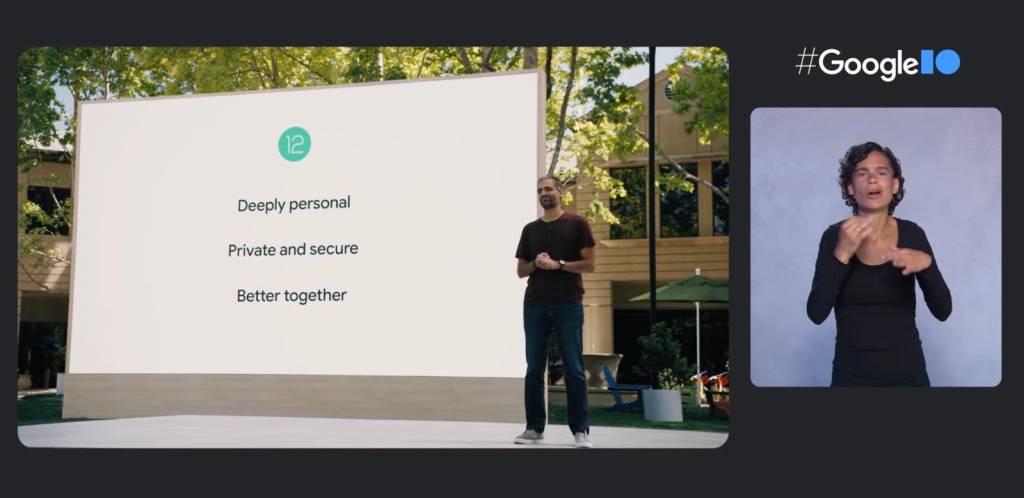Google skipped the I/O annual developers conference last year, as the novel coronavirus pandemic forced all tech companies to rethink their big announcements. Google can’t yet host the highly anticipated conference in person, as it did in previous years, but I/O is back in 2021 as a virtual keynote.
One of the show’s main attractions is Android 12, the next major Android update that will hit Pixel phones and other devices later this summer. The main Android 12 features were disclosed already, thanks to various leaks that we saw in the past few months. And, after all, developers have been using a developer preview beta mode for a few months now, well ahead of the public beta release that will soon be available to qualifying devices.
At I/O 2021, Google unveiled Android 12 in full, complete with a massive design overhaul and several exciting new features.
Android 12 is “deeply personal,” “private and secure,” and works “better together” with other devices, Google explained during the Android segment of I/O 2021.

Android 12 brings over a massive redesign, bringing over a new color palette, new buttons and sliders, and an overall more fluid app experience. That’s the new “Material You” design.
A new feature in Android 12 will let users customize the look of their phone “on the fly” without requiring an actual theme, with apps adapting automatically. That’s the new “color extraction” feature that lets you use colors from a photo to create a new theme instantly.
Material You customizations will be available initially to Pixel phones this fall, followed by other Google devices and the web.

All the menus and UI elements are curvier, and they can dynamically adapt to what’s on the screen. The design is more playful right from the lock screen, adjusting to the contents on the screen dynamically, as seen in these animations. But the new animations will not be taxing the phone’s resources:
Your Android devices are now faster and more responsive with better power efficiency so you can use your device for longer without a charge. This was achieved by some under-the-hood improvements including reducing the CPU time needed for core system services by up to 22% and reducing the use of big cores by the system server by up to 15%.
The Quick Settings panel also features a few visual changes in Android 12. Icons are placed on two columns and will include support for Home devices and Google Pay.

The software update brings over a few new widgets, including a new audio player, a quirky clock, and a weather widget that looks even better than the more boring weather widgets you’d expect to see on computers and smartphones.
A new Google Assistant invocation method is available to users; just long-press the power button to summon the virtual assistant.

Google brings new privacy features to Android 12, as expected. Phones and tablets running the latest Android release will show indicators at the top of the screen, signaling to the user that the camera and/or the microphone are currently in use. That’s a great feature to have especially if you think someone might be looking to spy on you. It’s also a great feature to have to prevent misuse from apps that abuse permissions.
By tapping on those indicators, users will be able to see exactly what apps accessed the microphone or camera and tweak permissions accordingly. Disabling access to both sensors for all apps is also available. These indicators are already available on iPhone, but Google takes them a step further, offering users more information about the apps that use these phone features. The new “Privacy dashboard” will also inform users about the kind of data Google apps collect from phones. Location data handling is also included in the new privacy panel.

Android 12 will also work together with Chrome to help users manage passwords for apps and services, according to an earlier segment of the show that focused on Google’s privacy and security practices across products.
The Android “Private Compute Core” will ensure Google can’t collect personal data from certain Android apps. Smart AI features like “Now Playing” and “Smart Reply” are powered by this new private computer core feature.

A “Locked photos” section is also coming to Android 12, which can be protected with a password or fingerprint sensor. The images in the folder will not show up in your photos feed.
Android 12 also seems to support native support for under-display fingerprint sensors, which might be an indication that next-gen Pixel devices like the Pixel 6 might support this popular biometric authentication method.
“Better together” is a new initiative that will allow different gadgets to work together, including Android and Chrome, Android and TVs, and Android and cars. Car key is launching this fall with support from BMW and other automakers, with Pixel and Galaxy phones being the first handsets to support the feature.

Some of these features will be available immediately to Android users today, as the Android 12 public beta 1 releases on Pixel phones and devices from 10 other handsets makers, including Asus, OnePlus, Oppo, Realme, Sharp, TCL, Vivo, Xiaomi, and ZTE. More information is available at this link.








